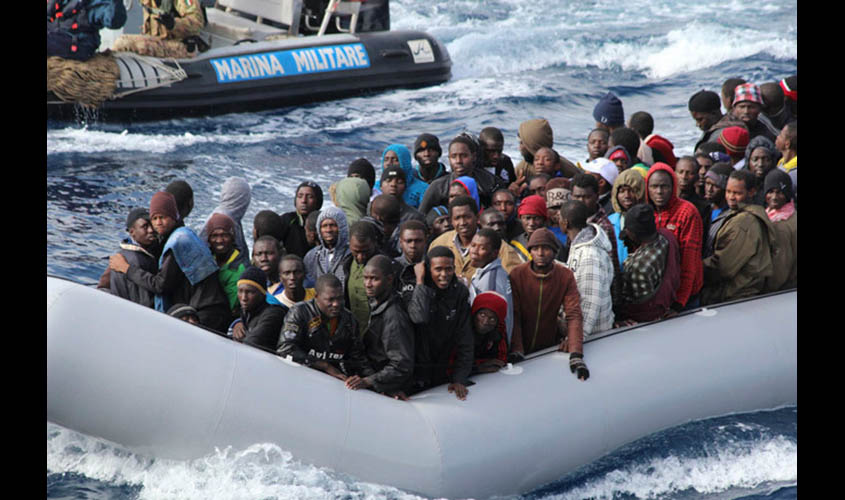As the climate at sea becomes more tolerable for the passage over the Mediterranean from North Africa, scores of migrants take to expensive, illegal and unseaworthy boats to smuggle themselves from Libya to Italy. Between January 2015 and January 2017, it is estimated that 428,635 refugees and migrants arrived in Europe by sea, with 2,257 estimated dead or missing. According to the UN Refugee Agency, Italy has already received 93,337 arrivals in 2017, an average of 450 per day. So far, the Italians have been hospitable, but the numbers are simply overwhelming the agricultural south of Italy, where unemployment is high and the infrastructure to cope is poor. Italy feels neglected by the European Union members, who have refused to take a fair share of the total number. Refugees from persecution are much fewer than the combined migrants from Bangladesh, Nigeria, Afghanistan, Somalia, Pakistan, Eritrea, Sudan, Mali, Gambia and Cote d’Ivoire, of whom 74% are young men, who see Sicily and Italy as the gateway to Europe and increased prosperity. With arrivals peaking in June, the government of Italy was so desperate to limit migratory movement from West Africa, that it considered suspending the disembarkation of people rescued at sea from NGO vessels under flags of other countries. It threatened to issue temporary EU visas to the 200,000 migrants already in overflowing government reception centres, which would have allowed them to travel north through Europe.
Since March 2016, the pressure has been removed from Greece, following the EU-Turkey agreement that allowed “irregular migrants” flowing across the Aegean from Turkey to be returned; this in exchange for EU member states resettling Syrian refugees residing in Turkey, visa liberalisation for Turkish nationals and augmentation of financial support for Turkish refugee camps. In 2017, Greece has received only 10,725 new arrivals. Italy is geographically the next best entry point to Europe. It is improbable the EU would settle for an agreement with Libya to halt the maritime departures and return the migrants to their countries of origin; it would be against their anti-refoulement principles. Anyway, how would the logistics and financing of such an agreement work and would Libya’s interim Government of National Accord have the political authority to implement such an agreement? The migrant situation is likely to worsen as there are millions more in Sub Saharan Africa, waiting to make this journey. The pervasion of technology has given them the preview of a quality of life in Europe they cannot achieve at home.
Nicholas Farrell reported in this week’s Spectator magazine that the NGOs’ humanitarian efforts are exacerbating the crisis. Apparently, smugglers are counting on NGO vessels to “rescue” their passengers near the point of departure. Farrell refers to Italian evidence of communications between traffickers and certain NGO boats. Some of the Open Society Foundations, neoliberal billionaire George Soros’ political activism network that are understood to promote unlimited migration and open borders, have been accused of sponsoring immigration to Italy. Farrell concludes that, intentionally or not, charities are colluding with people traffickers. Carmello Zuccaro, the chief prosecutor of Catania in Sicily, has a hypothesis of some NGO wrongdoing, in that smugglers in Libya and other North African countries may have links to criminal or extremist groups.
The Frontex Operation (the European Border and Coast Guard Agency) only operates 120 miles from the Libyan coast. It assesses whether a vessel carrying migrants is in an emergency situation, and if so, they are rescued and taken to Italy. In Malta, earlier this year, the EU examined reallocating the search and rescue responsibility to Southern Partners, thus decoupling rescue missions from territorial access to European international protection. This week, Frontex and the Italian authorities held a meeting in Warsaw to discuss the management of migrants in European waters and introducing a new code of conduct for NGOs.
Ideally, the Schengen area is without internal border checks. It requires a common policy from member states on the external borders, but recently, as a result of threats to their internal security, France, Germany, Austria, Denmark, Sweden and Norway have introduced temporary border controls. The EU is aware of the heightened terrorist and “foreign fighters” threat, accordingly it has adopted mandatory checks on EU citizens entering or exiting the Schengen area via land, sea and air borders. Within Schengen, travelling citizens would be checked against the Schengen Information System database and the Interpol Stolen/Lost Travel Documents database.
In January 2017, YouGov published a poll stating 69% of all UK respondents responded that immigration rules should be tightened. As the EU ponders its immigration management and revision of its “smart borders”, the certainty is that in negotiating Brexit, UK needs to exit the single market in order to control Britain’s immigration policy.

